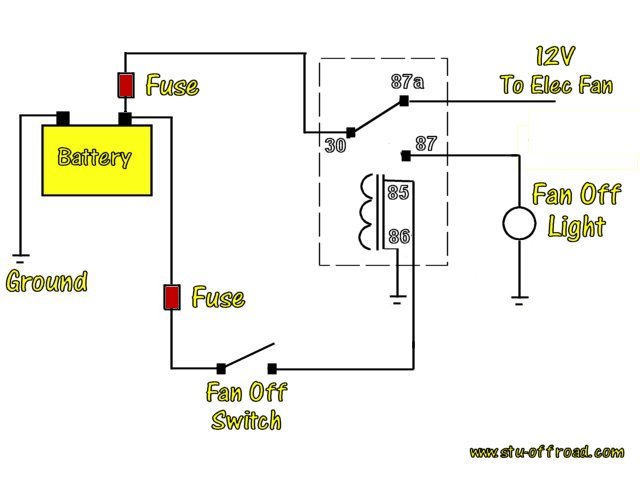Every now and then you need to temporarily disable an electrical circuit that is normally on. I don’t mean that you need to unplug it for a week or two but rather you need to turn it off for a minute and then back on. For example…..the 12 volt cooling fan on my transmission cooler has its own thermostatically controlled switched and the fan is wired directly to the battery via a fuse. Wired in this fashion, it allows the cooling fan to energize when ever the thermostat requires it. The problem arises when I need to turn off the fan while doing a water crossing. I could pull the fuse but that is a big headache and I would more than likely not stop to do it. What would work much better is to install a relay, let’s call it a bypass relay, and turn on the relay when I don’t want the fan to run…..that’s right, I said turn ON the relay when I don’t want the fan to operate. Let’s see how that is done.
Usually, we use a relay to turn things on. We connect the wires to the relay contacts so that the device receives electrical power (perhaps a pair of driving lights) when we energize the relay by turning on our switch. I could connect the bypass relay for my tranny cooler fan in this fashion…..but the problem there is that the relay always has to be on in order for the cooling fan to turn on and off via its thermostat. That would work but I would just as soon not keep the relay energized all the time. In all reality, I am only going to turn the fan off for about 30 seconds every couple of wheelin’ trips. In my opinion, that doesn’t warrant the relay staying on all the time just so I can turn it off for a few seconds a few times each month.

However, the regular 12V automotive relays that are commonly used provides a handy alternative for us. The trick is to use the other power contact on the relay, pin 87a (in the above diagram). Pin 30 and pin 87a are always connected UNLESS we energize the relay. This means that all day long, day after day, week after week, the 12V fan on the tranny cooler can always have an uninterrupted supply of power AND the relay will not be energized. THEN….when I need to temporarily remove power from the tranny cooler fan, I can energize the relay and interrupt the power flow to the fan.
In the diagram above, the relay contacts are shown in their de-energized positions. The +12V applied to pin 30 (from the battery) is connected to pin 87a. Pin 87a is connected to the positive lead of the 12V cooling fan. When the fan bypass switch (labeled fan off switch) is turned on, +12V is applied to the relay’s coil and causes it to energize. When this happens, pin 30 is connected to pin 87. This interrupts the power flow to the cooling fan and prevents it from running when the vehicle is crossing the river. At the same time, the Fan Off light is illuminated. The light is a visual reminder for the driver that the tranny cooling fan has been temporarily disabled. It is mounted on the dash in a conspicuous location so that it can be readily noticed. When the water crossing is finished, the fan bypass switch is turned off. This extinguishes the Fan Off light and restores power to the tranny cooling fan.
In summary, by using the normally closed set of contacts (pins 30 and 87a), we can provide power to the cooling fan’s thermostat without having to keep the relay energized. This will ensure a very long life for the relay (since it will hardly ever be energized) and makes for an efficient method by which to control the fan. Of course, if the cooling fan does not have its own internal thermostat, this circuit would only cause the fan to run 24 hours a day…..not exactly the results we are looking for.
Enjoy your Jeep and remember to TREADLightly!
